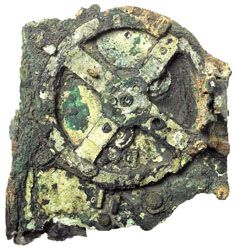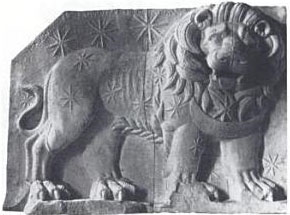The Antikythera Mechanism Was Used for Astrology
Posted by Chris Brennan on Tuesday, December 16 2008
 In 1901 a group of sponge divers discovered a complex mechanical device lying at the bottom of the ocean, just off the coast of a Greek island named Antikythera. The device subsequently became known as the Antikythera mechanism.
In 1901 a group of sponge divers discovered a complex mechanical device lying at the bottom of the ocean, just off the coast of a Greek island named Antikythera. The device subsequently became known as the Antikythera mechanism.
It was found amongst the remains of a shipwreck that took place sometime around the early 1st century BCE, although the device itself is thought to have been constructed sometime between 150-100 BCE.
Over the course of the past century researchers slowly came to realize that the Antikythera mechanism is a mechanical calculator or analog computer that was designed in order to calculate the positions of the planets and other astronomical cycles, simply by setting the device for a certain date.
Some of these astronomical cycles were displayed within the context of the twelve sign zodiac as well as the Egyptian calendar, which are inscribed on the device, and it also had a dial for predicting eclipses.
What Is The Purpose of the Antikythera Mechanism?
The Antikythera mechanism has been widely hailed as the most complex mechanical device to have been constructed in the ancient world, completely rewriting our understanding of ancient science and mechanics. Yet, the actual purpose of the device is seldom mentioned or explored with much depth.
Why? Because primary purpose for constructing such a device during that time period would have been to use it for astrological purposes. That is to say, it would have been used to calculate and construct birth charts, or other astrologically related charts for inceptional and electional astrology (a.k.a. katarchic astrology).
Essentially what this means is that the most sophisticated mechanical device in the ancient world was used for the purposes of what many modern scientists consider to be a superstition or pseudoscience.
Naturally this is a pretty hard pill to swallow for many modern astronomers and scientific types who are so excited about the discovery of the Antikythera mechanism, but completely unexcited about talking about what it was likely used for (astrology), so naturally this facet of the device gets glossed over and downplayed.
I think that this is problematic though, because in downplaying the practical applications of the device researchers may overlook certain design features that it might contain.
Additionally, the Antikythera mechanism may provide us with some important information about the interaction between astronomy and astrology in the ancient world, and how each field served an important role in spurring on the development of the other.
The Antikythera Mechanism and the Development of Hellenistic Astrology
One particularly interesting feature of the Antikythera mechanism is the fact that it may help us to firmly establish the time frame for the development of Hellenistic astrology.
At the moment there is a bit of a debate going on about about whether or not Hellenistic astrology developed gradually over the course of several centuries, or whether it was the result of a more sudden ‘invention’ that took place over the course of one or perhaps two generations.
The majority of researchers in the field of ancient astrology at the present time tend to argue more along the lines of the sudden invention hypothesis, usually pinpointing the development of Hellenistic astrology to the late 2nd or early 1st century BCE.[1]
What is interesting about this dating is that it coincides precisely with the period in which the Antikythera mechanism is thought to have been constructed and subsequently lost in the shipwreck.
It seems highly doubtful that this is a coincidence though, but instead it seems to point to the possibility that the early founders of Hellenistic astrology were somehow connected with the developments that were taking place around the Antikythera mechanism.
Possible Scenarios of Reciprocal Influence
On the one hand it is possible that the development of devices like the Antikythera mechanism (surely there were similar devices or at least prototypes) actually spurred the development of Hellenistic astrology, by providing the tools necessary in order to calculate the positions of the planets for a specific date in a relatively quick and easy manner.
This would have sped up and perhaps improved the astrological research that was taking place at the time, possibly making it easier to accomplish the synthesis of the Mesopotamian and Egyptian astrological traditions that resulted in the development of Hellenistic astrology.
On the other hand, perhaps it was this new system of astrology, and the rising practice of natal astrology since its inception in the 5th century BCE, that necessitated and spurred the development of more complex devices like the Antikythera mechanism. These devices would have been developed in order to compute the necessary astronomical calculations for casting an astrological chart in a much quicker and more accurate fashion than simply by doing it by hand from tables and ephemerides.
By the late 1st century BCE horoscopic astrology had completely incorporated and displaced the earlier Mesopotamian and Egyptian traditions of astrology, and it became pervasive in Roman culture and politics. So, it would not be surprising to see a wealthy patron expending great sums of money in order to commission a device that would make the calculations of his astrologer, or team of astrologers, more efficient and accurate.
The 1st century stone engraving at Nemrud Dag that displays the positions of the planets at the coronation of King Antiochus I of Commagene, which is often thought to be one of the earliest Greek ‘horoscopes’, is a good example that astrologers during that time were sometimes in the position to have wealthy and high ranking patrons. Could an astrologer or a group of astrologers have been in the position to have a device like the Antikythera mechanism commissioned during this time period? It seems highly probable, although perhaps not without some sort of external support.
They say that the ship that was carrying the Antikythera mechanism was on its way to Rome when it sank, although we will probably never know who it was originally intended for. There is one thing that seems certain though: the existence of such a device, or such devices, would have had profound implications for the development and practice of astrology in the ancient world.
While the discovery of the Antikythera mechanism may rewrite the history of mechanics significantly, it also provides us with another important example of one of the more positive contributions that astrology has made to the history of science.
More Information on the Antikythera Mechanism
- The team that has been carrying out research on the Antikythera mechanism over the past few years has a website with a lot of up-to-date news and information on the subject.
- Wikipedia’s article contains a lot of useful links to recent articles that have been published, as well as a more or less accurate overview of the Antikythera mechanism.
- There is a recent video on Nature.com that provides some interesting information on how the Antikythera Mechanism Research Project has been conducting their investigations.
- There is a video clip on YouTube which shows a working reconstruction of the Antikythera mechanism that was built by a museum curator named Michael Wright.
- The History Channel produced a really great hour-long episode on the Antikythera mechanism a couple of years ago that had some nice computer generated images and animations of the device. It is slightly of out of date now, but I would still highly recommend checking out that video if you get a chance. You can purchase the DVD from Amazon.com. Here is a short clip from it that I found on YouTube:
Endnotes
- See David Pingree, From Astral Omens To Astrology, From Babylon to Bikaner, Istituto Italiano Per L’Africa E L’Oriente, 1997, pg. 34.











Δεν υπάρχουν σχόλια:
Δημοσίευση σχολίου